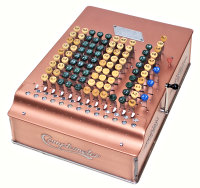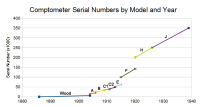John Wolff's Web Museum
The Felt & Tarrant Model J Comptometer - Technical Description
Contents
|

|
| Model J Comptometer, c.1926 |
Introduction
These pages give a detailed technical description of the internal
mechanism of the Felt & Tarrant Model J Comptometer. The description
can also be used (with suitable modifications) with any of the
manually-operated "rock frame" Comptometers (Models H, J, M, WM,
and 3D11) that were manufactured from 1920 to the 1960s. In the
earlier Models A to F the keyboard and actuating mechanisms are
generally similar to the Model J, but the register and clearing
mechanisms are different. The electric machines (Models K, 992, 99C)
use similar rock frame and register mechanisms to the Model J, but
the keyboard and actuating mechanisms are different. Descriptions
of other models may be added if there is sufficient interest.
The notes and photographs following were first prepared during the
overhaul of a 12-column Sterling machine (Model J, S/N 254299) in
2002-3. They have been refined and expanded during the rebuilding of
many Comptometers since. While I believe my descriptions to be
substantially correct, I do not guarantee that they are
entirely accurate or complete. No responsibility will be taken for
any consequences arising from the use of these notes by others.
Readers seeking to rebuild or restore a Comptometer will find detailed
step-by-step instructions on the Rebuilding pages.
I am indebted to the late Mr Ray Mackay of Melbourne (formerly
Service Manager for Peacock Bros, the Comptometer agents in Australia)
for his assistance and encouragement with this project.
I would be happy to receive feedback, comments, or suggestions via
the enquiry form.
Summary of Comptometer dates, models, and mechanisms.
 Comptometer model names refer only to the construction of the
internal mechanism, and not to the number of columns or the
arrangement of the keyboard. The machines were generally made with
8, 10, or 12 keyboard columns, but larger machines were available on
special order. Non-decimal versions included machines for British
currency (with or without farthings), Indian currency, hours and
minutes, and Imperial lengths and weights.
Comptometer model names refer only to the construction of the
internal mechanism, and not to the number of columns or the
arrangement of the keyboard. The machines were generally made with
8, 10, or 12 keyboard columns, but larger machines were available on
special order. Non-decimal versions included machines for British
currency (with or without farthings), Indian currency, hours and
minutes, and Imperial lengths and weights.
The graph opposite shows the (approximate) progress of serial
numbers by model and year for the "copper-cased " or "shoebox"
Comptometers Models A to J. (Click the graph to enlarge).
Felt & Tarant's first machines (1886-1903) were housed in
rectangular wooden cases, and were known simply as "Comptometers"
without a model designation. The early mechanism required the keys to
be pressed one-at-a-time, and had no operating safeguards.
The metal-cased "Model A Duplex Comptometer" from 1904 added a new
automatic mechanism which allowed keys in adjacent columns to be
pressed simultaneously, so that multi-digit multipliers and divisors
could be entered at a single stroke.
Model B (1906) added "cut-off levers" to remove the need for filling
the keyboard with nines on subtraction.
Model C (two versions, 1909 and 1911) reduced the force required to
operate the keys and improved the visibility of the register. Many of
the mechanical parts were redesigned for greater strength and
durability.
The Model E (1913) introduced the "Controlled-key" mechanism. This
involves an automatic "trigger" which detects incomplete keystrokes
and allows the operator to correct them without needing to re-start
the calculation. Model E was also the first (and only) Comptometer to
have "interference guards" to eliminate errors from accidental
movement of adjacent keys.
Model F (1915) re-calibrated the trigger mechanism and removed the
interference guards. Production of Model F Comptometers (over 40,000
machines in 5 years) exceeded the total of models A to E combined.
Models A to F all have a a permanently-engaged register drive. To
clear the machine, the forward stroke of the clearing handle advances
all the register dials 9 (or their maximum capacity). The mechanism
then injects a 1 into the first column, initiating a ripple carry and
leaving the register at zero.
The Model H (1920) separated much of the tens-carry mechanism into
a removable "rock frame" at the front of the machine. A light touch of
the clearing handle would rock the frame forward, disconnecting the
register drive and allowing the carry springs to return the dials to
zero. A triple "start from clear" signal was added, and the case was
further decorated with a large Comptometer name front and rear.
The Model J (1926) was the last of the "shoebox" Comptometers. It
was essentially the same as the Model H, except for some modifications
to the carry gear and escapement levers, and a re-calibration of the
springs to provide a lighter touch. The keytops changed to green and
white, using a new synthetic polymer material which has not lasted
well. There was considerable overlap between models H and J at the
time of transition, and there were many changes and improvements made
during the 13 years of production.
Model K (1934) was the first electric Comptometer. It uses a similar
rock-frame and register mechanism to the Model J, but has a completely
different keyboard and a power-driven actuator. The Controlled-key
mechanism still works in exactly the same manner as on the previous
models. Model K has a deep brown painted case with short legs at
the rear.
The manually-operated Model M (1939) has a green-painted case in a
more rounded "Art-deco" style. The mechanism has leading-zero shutters
on the numeral wheels, latches on the subtraction levers, and further
refinements to the touch. Some of the parts were made from aluminium.
The "war model" WM was the same as the M but with many parts
redesigned to conserve materials.
The final changes occurred in 1950. The electric Model K was updated
to become the Model 992, with the case and register display from the
Model M and an automatic start-stop mechanism for the motor. Model M
became Model 3D11, with changes to the Controlled-key mechanism to
provide automatic re-setting during multiplication and division.
Resources for Further Information
- The comptometers
page on this site gives general information about key-driven
calculators from Felt & Tarrant, Burroughs, and other manufacturers.
- The Description of Comptometer Operation, prepared by Mr
Ray Mackay of Melbourne, Australia, in 1997, and available on
James Redin's web site,
gives a first-hand description of the principles and operation of the
Comptometer mechanism, as recalled from Ray's personal experience as
a service engineer in the 1950 and 60s.
- Brooke Boering's "Comptometer Reference Site" provided a wealth of
detailed information about the early history and products of the
Felt & Tarrant company. The original site is now off-line, but
archived versions can be found by searching web.archive.org for
members.cruzio.com/~vagabond/ComptHome.html
- The Repair Instructions for the Model H Comptometer,
published by Felt & Tarrant in 1919 is available in HTML format on
the Comptometer Reference Site (see note above). This manual gives an
authoritative description of the mechanism and its individual
components, from the viewpoint of a factory-trained serviceman
in the field.
- The Technical Description of the
Bell Punch "PLUS" (on this site) describes a rather different
mechanism which addresses the same ends. The PLUS developed into the
Sumlock machine, which
became the new-model Comptometer in the 1960s.
Original text and images Copyright © John Wolff 2004-2022.
Use at own risk; beware of errors; suggestions for improvement welcome.
Page created: 2004. Last Updated: 7 February 2022.
Next: The case and frame
Back to: Home
Calculating Machines
Key-driven calculators
Comptometer
Model J
Tech Index

